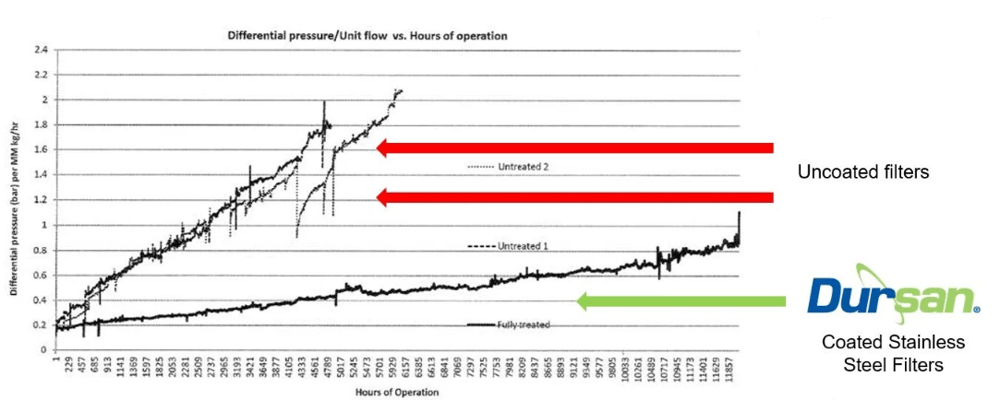This week's topic: all things filters! Whether it's stainless steel, Hastelloy®, or other alloys - filters play a critical role in protecting systems and ensuring product integrity. But they face constant threats: corrosion, fouling, and chemical interaction. Over time, these issues shorten filter life, raise maintenance costs, and compromise performance. Our gas-phase chemical vapor deposition (CVD) coating method ensures that the it penetrates even the smallest porous media without blocking the pores, allowing for 100% surface coverage.
SilcoTek has spent years testing how CVD coatings can solve these problems. The results show that applying ultra-thin silicon-based coatings like Dursan®, Silcolloy®, SilcoNert® 2000, or our monolayer surface treatment, Notak® 2000, dramatically improves filter durability and reliability without clogging pores.

The Problems With Bare Metal Filters
Corrosion Vulnerability
Even high-performance alloys degrade in aggressive environments:
| Material / Filter Type |
Environment |
Corrosion Rate (MPY) |
Mass Loss % |
| SS Tubing (electropolished) |
6M HCl, room temp |
16.753 |
— |
| Hastelloy C-22 Tubing |
6M HCl, room temp |
0.673 |
— |
| Hastelloy C-22 Powder Filter |
6M HCl, 24 hrs @ RT |
~1.4 |
1.9% |
| Hastelloy C-22 Fiber Filter |
6M HCl, 24 hrs @ RT |
~7.1 |
9.5% |
Takeaway: Sintered fiber filters corrode up to 10× faster than wrought tubing, limiting reliability in aggressive applications.
Surface Interaction and Contamination
- Stainless steel surfaces adsorb analytes (i.e., sulfur, ammonia, mercury), causing slow system response and distorted results in analytical applications.
- Metal ion leaching can contaminate sensitive life science or pharmaceutical processes.
Fouling and Pressure Drop
- Fouling clogs filter pores, increasing differential pressure.
- Uncoated filters in accelerated fouling simulations showed rapid pressure buildup, reducing service life by half.
Why SilcoTek CVD Coatings Work
Unlike paint or plating, CVD coatings are:
- Non-line-of-sight: gaseous precursors penetrate small pores and complex geometries.
 Cross section of a frit that was coated with SilcoNert 2000. While there is a gradient of thickness from the center of the frit to the edges, the difference in coating thickness is only about 30 nm from the center to the edge.
Cross section of a frit that was coated with SilcoNert 2000. While there is a gradient of thickness from the center of the frit to the edges, the difference in coating thickness is only about 30 nm from the center to the edge.
- Ultra-thin: typical internal coating thickness in 2 µm pores is just 50–80 nm, compared to ~500 nm on flat surfaces.
- Reliable: hardness and wear data suggest that coated filters are robust and can withstand abrasion in installation, plus any micro-particulate that may be flowing through process streams.
- Uniform: SEM/EDS mapping confirms even coverage throughout powder and fiber filter structures.
 EDS maps of silicon at a high magnification within the sintered frit showing that all pores are coated.
EDS maps of silicon at a high magnification within the sintered frit showing that all pores are coated.
Common applications for SilcoTek CVD-coated filter media:
- Refinery and chemical processes with sticky or corrosive gases
- Pharmaceutical manufacturing
- Chromatography
- Semiconductor manufacturing
- Process analysis and control
- Food and beverage
Performance Improvements & Data
1. Corrosion Resistance
Silcolloy dramatically reduced corrosion rates in Hastelloy filters:
| Filter Type |
Uncoated Corrosion Rate (MPY) |
Silcolloy Coated Rate (MPY) |
Improvement |
| Powder |
~1.4 |
0.008 |
175× |
| Fiber |
~7.1 |
0.011 |
645× |
2. Chemical Inertness and Adsorption Control
- SilcoNert 2000: prevents sulfur and ammonia adsorption, improving response time and recovery in gas sampling systems.
- Dursan: minimizes ion leaching, protecting chromatography and life science analyses.
Example: Coated filters showed nearly 100% analyte recovery, while uncoated steel surfaces delayed response and trapped sulfur compounds.
/SilcoNert%20Improves%20System%20Response.png?width=529&height=388&name=SilcoNert%20Improves%20System%20Response.png)
3. Anti-Fouling and Hydrophobicity
- Contact angle measurements show:
- Uncoated stainless steel: ~30–40° (wetting)
- Dursan: ~90° (hydrophobic)
- Notak 2000: >100° (super-hydrophobic)
- In fouling simulations, Dursan filters cut pressure buildup by 50% and lasted nearly 2× longer than uncoated filters.

4. Reduced Wear and Friction
Pin-on-disc wear testing:
- Dursan delivered a 50% reduction in wear rate
- 35% lower coefficient of friction compared to oxidized stainless steel

SilcoTek’s CVD coatings - Silcolloy, Dursan, SilcoNert 2000, and Notak 2000 - have been proven to:
- Reduce corrosion by up to 645×
- Double filter lifespan by reducing fouling and pressure drop
- Prevent adsorption and contamination for cleaner analytical results
- Improve lubricity and wear resistance
By enhancing metal filters without clogging pores, SilcoTek coatings extend service life, reduce maintenance, and improve process reliability across industries—from energy and petrochemicals to semiconductors, life sciences, and analytical chemistry.
If you have questions about SilcoTek-coated filters, frits, or other porous materials, please reach out to our team!


/SilcoNert%20Improves%20System%20Response.png?width=529&height=388&name=SilcoNert%20Improves%20System%20Response.png)



